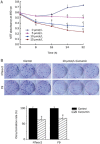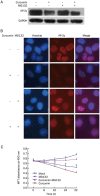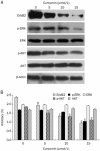Curcumin inhibits AP-2γ-induced apoptosis in the human malignant testicular germ cells in vitro
- PMID: 23685957
- PMCID: PMC4003153
- DOI: 10.1038/aps.2013.38
Curcumin inhibits AP-2γ-induced apoptosis in the human malignant testicular germ cells in vitro
Abstract
Aim: To investigate the effects of curcumin on proliferation and apoptosis in testicular cancer cells in vitro and to investigate its molecular mechanisms of action.
Methods: NTera-2 human malignant testicular germ cell line and F9 mouse teratocarcinoma stem cell line were used. The anti-proliferative effect was examined using MTT and colony formation assays. Hoechst 33258 staining, TUNEL and Annexin V-FITC/PI staining assays were used to analyze cell apoptosis. Protein expression was examined with Western blot analysis and immunocytochemical staining.
Results: Curcumin (5, 10 and 15 μmol/L) inhibited the viability of NTera-2 cells in dose- and time-dependent manners. Curcumin significantly inhibited the colony formation in both NTera-2 and F9 cells. Curcumin dose-dependently induced apoptosis of NTera-2 cells by reducing FasL expression and Bcl-2-to-Bax ratio, and activating caspase-9, -8 and -3. Furthermore, curcumin dose-dependently reduced the expression of AP transcription factor AP-2γ in NTera-2 cells, whereas the pretreatment with the proteasome inhibitor MG132 blocked both the curcumin-induced reduction of AP-2γ and antiproliferative effect. Curcumin inhibited ErbB2 expression, and decreased the phosphorylation of Akt and ERK in NTera-2 cells.
Conclusion: Curcumin induces apoptosis and inhibits proliferation in NTera-2 cells via the inhibition of AP-2γ-mediated downstream cell survival signaling pathways.
Figures






Similar articles
-
[Gefitineb inhibits the growth and induces the apoptosis of mouse I-10 Leydig testicular cancer cells in vitro].Zhonghua Nan Ke Xue. 2015 Sep;21(9):797-802. Zhonghua Nan Ke Xue. 2015. PMID: 26552212 Chinese.
-
Effects of curcumin on bleomycin‑induced oxidative stress in malignant testicular germ cell tumors.Mol Med Rep. 2012 Oct;6(4):860-6. doi: 10.3892/mmr.2012.991. Epub 2012 Jul 17. Mol Med Rep. 2012. PMID: 22825355
-
Cisplatin-induced apoptosis in human malignant testicular germ cell lines depends on MEK/ERK activation.Br J Cancer. 2004 Aug 2;91(3):589-98. doi: 10.1038/sj.bjc.6601919. Br J Cancer. 2004. PMID: 15266324 Free PMC article.
-
Curcumin-mediated regulation of Notch1/hairy and enhancer of split-1/survivin: molecular targeting in cholangiocarcinoma.J Surg Res. 2015 Oct;198(2):434-40. doi: 10.1016/j.jss.2015.03.029. Epub 2015 Mar 19. J Surg Res. 2015. PMID: 25890434 Review.
-
Roles of activator protein-2 gamma in breast cancer: A narrative review (SANRA).Medicine (Baltimore). 2022 Sep 23;101(38):e30587. doi: 10.1097/MD.0000000000030587. Medicine (Baltimore). 2022. PMID: 36197225 Free PMC article. Review.
Cited by
-
Cordycepin-induced unfolded protein response-dependent cell death, and AKT/MAPK-mediated drug resistance in mouse testicular tumor cells.Cancer Med. 2019 Jul;8(8):3949-3964. doi: 10.1002/cam4.2285. Epub 2019 May 30. Cancer Med. 2019. PMID: 31145545 Free PMC article.
-
ErbB Proteins as Molecular Target of Dietary Phytochemicals in Malignant Diseases.J Oncol. 2017;2017:1532534. doi: 10.1155/2017/1532534. Epub 2017 Feb 13. J Oncol. 2017. PMID: 28286519 Free PMC article. Review.
-
Exploring the role of natural bioactive molecules in genitourinary cancers: how far has research progressed?Nat Prod Bioprospect. 2023 Oct 16;13(1):39. doi: 10.1007/s13659-023-00400-4. Nat Prod Bioprospect. 2023. PMID: 37843642 Free PMC article. Review.
-
Midazolam activates caspase, MAPKs and endoplasmic reticulum stress pathways, and inhibits cell cycle and Akt pathway, to induce apoptosis in TM3 mouse Leydig progenitor cells.Onco Targets Ther. 2018 Mar 15;11:1475-1490. doi: 10.2147/OTT.S154442. eCollection 2018. Onco Targets Ther. 2018. PMID: 29588601 Free PMC article.
-
Crosstalk between metabolism and cell death in tumorigenesis.Mol Cancer. 2024 Apr 4;23(1):71. doi: 10.1186/s12943-024-01977-1. Mol Cancer. 2024. PMID: 38575922 Free PMC article. Review.
References
-
- Iczkowski KA, Butler SL. New immunohistochemical markers in testicular tumors. Anal Quant Cytol Histol. 2006;28:181–7. - PubMed
-
- Aggarwal BB, Kumar A, Aggarwal MS, Shishodia S. Curcumin derived from turmeric (Curcuma longa): a spice for all seasons. Phytopharm Cancer Chemopreven. 2005. pp. 349–87.
-
- Anand P, Sundaram C, Jhurani S, Kunnumakkara AB, Aggarwal BB. Curcumin and cancer: an “old-age” disease with an “age-old"”solution. Cancer Lett. 2008;267:133–64. - PubMed
-
- Kunnumakkara AB, Anand P, Aggarwal BB. Curcumin inhibits proliferation, invasion, angiogenesis and metastasis of different cancers through interaction with multiple cell signaling proteins. Cancer Lett. 2008;269:199–225. - PubMed
Publication types
MeSH terms
Substances
Supplementary concepts
LinkOut - more resources
Full Text Sources
Other Literature Sources
Medical
Research Materials
Miscellaneous

